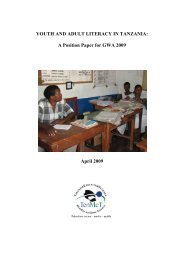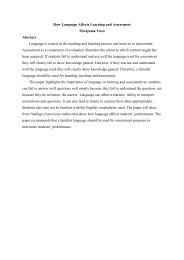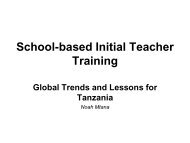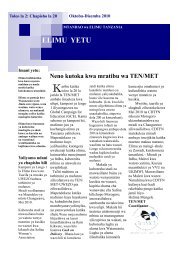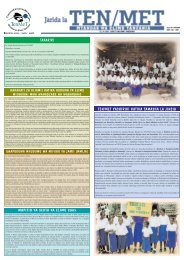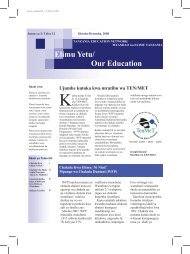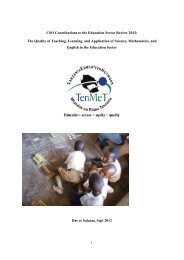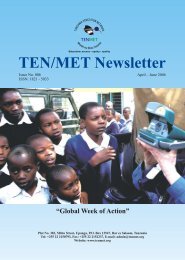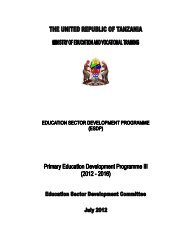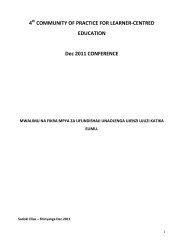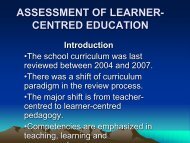REPORT - Tanzania Education Network/Mtandao wa Elimu Tanzania ...
REPORT - Tanzania Education Network/Mtandao wa Elimu Tanzania ...
REPORT - Tanzania Education Network/Mtandao wa Elimu Tanzania ...
You also want an ePaper? Increase the reach of your titles
YUMPU automatically turns print PDFs into web optimized ePapers that Google loves.
<strong>REPORT</strong><br />
16 TH SEPTEMBER, 2010<br />
1
INTRODUCTION<br />
The Context of the 1Goal Campaign for EFA<br />
The 1GOAL campaign on <strong>Education</strong> For All (EFA) is a global campaign<br />
seeking to ensure that every child can get an education.<br />
2
<strong>Education</strong> Summit Statement<br />
• In 2010 the campaign <strong>wa</strong>s supported by the Football<br />
Association (FIFA)- World Cup held in south Africa<br />
• The state leaders who participated in the world cup also held<br />
the <strong>Education</strong> Summit. Following below are the key summit<br />
statements;<br />
– <strong>Education</strong> is a fundamental human right enshrined in the<br />
1948 Universal Declaration of Human Rights. Thus<br />
everyone is entitled to free primary education to improve life<br />
and fully participate in society.<br />
– <strong>Education</strong> is a precondition for sustainable human<br />
development and a catalyst for the realization of MDGs.<br />
– With only five years left before the 2015 target date for EFA,<br />
the leaders call on the world community to give new<br />
impetus to education and scale up efforts to reach the MDG<br />
education targets.<br />
3
<strong>Education</strong> Summit statement<br />
– The governments must combat marginalization to<br />
ensure that the right to quality education is no longer<br />
a privilege for some, but a reality for all. All barriers<br />
limiting access to quality basic education must be<br />
removed.<br />
– The governments should translate their commitment<br />
to education into concrete actions, including<br />
increased financial allocations.<br />
4
1.2 <strong>Tanzania</strong> context<br />
• <strong>Tanzania</strong> interprets the 1goal campaign in education financing as<br />
one of the key agenda in ESDP with a focus to enhance the goals of<br />
EFA.<br />
• ESDP is a comprehensive programme aimed at transformation of the<br />
education system into the Output/outcome based sector to enhance<br />
the six EFA goals (early childhood care, complete free and<br />
compulsory primary education, equitable access to appropriate<br />
learning and life skills, adult literacy, gender equity, and quality in<br />
education and learning).<br />
• The EFA goals also uniquely fit into the overall goals of education<br />
sector reforms that inform the national vision 2025 on developing a<br />
well-educated and learning society by 2025.<br />
• Cluster II goals 1 and 2 of NSGRP (MKUKUTA) further inform the<br />
vision 2025 education targets by ensuring equitable access to quality<br />
education for promoting the national economic growth by<br />
harmonizing the planning processes at national and local levels.<br />
5
<strong>Tanzania</strong> context -----------<br />
• The need to address EFA goals necessitated<br />
the government to take initiatives to<br />
improvement of education policies and<br />
programmes;<br />
– 1995 <strong>Education</strong> and Training Policy (ETP)<br />
– PEDP(2002-2006), SEDP (2004-2009) & FEDP<br />
(2007-2011).<br />
• The reforms are also taking into account<br />
education factors to inform the JAST, SADC<br />
and EAC protocols.<br />
6
Objectives<br />
The objectives for this study were to;<br />
• Bring together key information and analysis on<br />
education financing issues in <strong>Tanzania</strong><br />
collected from 1goal campaign<br />
• Outline the key policy recommendations for<br />
improved EFA goals in future.<br />
• Provide important advocacy and lobbying on<br />
the 1goal campaign issues as evidenced by<br />
education CSOs.<br />
7
Method<br />
• Debriefing meetings with TEN/MET and<br />
government officials as well as other education<br />
CSO members.<br />
• Literature review <strong>wa</strong>s undertaken to review the<br />
TENMET and other authors’ documented<br />
opinion on 1goal campaign, specifically on<br />
education financing, challenges, and remedies<br />
taken to enhance EFA goals.<br />
• Interviews and discussions were guided by<br />
specifically designed research questions.<br />
8
Million Shillings<br />
Key Findings<br />
The current trend of<br />
education sector financing<br />
•The government has put efforts to<br />
improve the MoEVT budget<br />
allocation as % of total Government<br />
budget, education sector budget and<br />
GDP<br />
•Despite increasing the education<br />
sector budget from 1.7 trillion in<br />
2009/10 to 2.0 trillion in 2010/11, the<br />
share of education sector decreased<br />
by 0.7 % from 18.3 % in 2009/10 to<br />
17.6 % in 2010/11<br />
•This fluctuating education budget<br />
allocation also has implications for<br />
effective education financing<br />
process including compromising the<br />
implementation of EFA goals.<br />
14000000<br />
12000000<br />
10000000<br />
8000000<br />
6000000<br />
4000000<br />
2000000<br />
0<br />
Chart 4.1.1; MoEVT Budget Allocation as % of Total GVT Budget, and <strong>Education</strong> Sector<br />
2000/01<br />
2001/02<br />
2002/03<br />
2003/04<br />
2004/05<br />
2005/06<br />
2006/07<br />
2007/08<br />
2008/09<br />
2009/10<br />
* 2010/11<br />
Total Budget in mill.shs MOEVT Budget in mill.shs MOEVT Budget as % of Total budget<br />
9
• <strong>Education</strong> spending by area;<br />
primary, secondary and<br />
other basic education;<br />
- Although there has been a<br />
shift in education spending<br />
with increased spending to<br />
secondary education,<br />
vocational, and higher learning<br />
institutions.<br />
- Primary education remained<br />
the biggest beneficiary by<br />
taking 72 % of MoEVT’s<br />
budget.<br />
- Spending most of the budget<br />
on primary education could<br />
mean improvement of primary<br />
education facilities to enhance<br />
EFA goals in <strong>Tanzania</strong>.<br />
- This is not the case in practice.<br />
In the education sector the<br />
primary area is still faced with<br />
challenges regardless<br />
government efforts to invest in<br />
this sector.<br />
Chart 4.1.2 Trend of <strong>Education</strong> Funding by Levels<br />
2%<br />
7%<br />
19%<br />
72%<br />
Primary Secondary Vocatinal training O/Basic education<br />
10
<strong>Education</strong> Financing Shortfalls<br />
Chart. 4.2.1(a) PEDP II Budget estimates & Actual allocation<br />
Financing shortfalls in PEDPII<br />
- Financing performance indicates<br />
that there is a big gap between<br />
budget estimates and actual<br />
allocation.<br />
- On average the three years<br />
implementation of PDEP II <strong>wa</strong>s<br />
only 0.15%.<br />
- With this performance there is<br />
still a question of how EFA goals<br />
are to be achieved to enhance<br />
quality education for all<br />
<strong>Tanzania</strong>n children.<br />
350<br />
300<br />
250<br />
200<br />
150<br />
100<br />
50<br />
0<br />
2007/08 2008/09 2009/10 2010/11<br />
Fiscal Years<br />
PEDP II imple.costs Actual budget allocation<br />
11
Classroom Construction in PEDP I & II(2002-2008)<br />
• The chart indicates a<br />
wider gap between<br />
estimated and the<br />
actual classroom<br />
construction in PEDP II<br />
compared to PEDP I.<br />
• Poor financing of PEDP<br />
II has resulted to<br />
classroom<br />
overcrowding<br />
comparing the 2008<br />
classroom-pupil ratio<br />
(1:78) with that of 2002<br />
(1:77).<br />
25000<br />
20000<br />
15000<br />
10000<br />
5000<br />
0<br />
Chart: 4.2.1 (b) Classrooms constructions in PEDP I & II(2002-2008)<br />
PEDP II<br />
PEDP I<br />
PEDP Actual PEDP Estimates<br />
12
Pupils per Teacher<br />
Teacher-Pupil ratio<br />
• Poor construction of<br />
teacher houses<br />
increased teacherpupil<br />
ratio.<br />
• The teacher-ratio in<br />
PEDP I <strong>wa</strong>s still high<br />
(1:53) the situation<br />
continued to be tense<br />
in PEDP II<br />
implementation where<br />
teacher-pupil ratio<br />
reached 54 students for<br />
every teacher.<br />
59<br />
58<br />
57<br />
56<br />
55<br />
54<br />
53<br />
52<br />
51<br />
50<br />
49<br />
Chart: 4.2.1 (c) Teacher- Pupil Ratio<br />
1:54<br />
1:53<br />
2002 2003 2004 2005 2006 2007 2008<br />
PEDP I<br />
PEDP II<br />
13
Percent Passed<br />
Primary School Leaving Results<br />
• Financing gaps of<br />
PEDP has implications<br />
for the deteriorating<br />
rates of the Primary<br />
School Leaving<br />
Examination.<br />
• The information shows<br />
that performance <strong>wa</strong>s<br />
better in PEDP I (70.5<br />
%) and the trend<br />
continued to drop to<br />
52.7% in 2008<br />
80<br />
70<br />
60<br />
50<br />
40<br />
30<br />
20<br />
10<br />
0<br />
Chart: 4.2.1 (d) Primary School Leaving Examination Results<br />
70.5<br />
52.8<br />
2002 2003 2004 2005 2006 2007 2008<br />
PEDP I<br />
PEDP II<br />
14
Teachers Staffing Levels with respect to Sub-Sectors in Government<br />
Schools 2007/08<br />
Financial limitations to<br />
attaining a Teacher-Pupil<br />
Ratio to 1:45.<br />
•An <strong>Education</strong> Sector<br />
Performance Report<br />
(MoEVT, 2008) revealed<br />
that the education sector<br />
suffers from a serious<br />
deficit in teaching staff.<br />
•Table.4.2.2 and chart<br />
4.2.2 summarize the<br />
teaching staff levels with<br />
respect to enhancing the<br />
Teacher- Pupil Ratio of<br />
1:45 in government in<br />
2007/08<br />
SUB - SECTOR<br />
Available<br />
number of<br />
teachers<br />
Required number<br />
of Teaching<br />
staff<br />
2007/2008<br />
Deficit<br />
Pre-primary 14,763 32,216 17,453<br />
Primary 149,433 184,369 34,936<br />
Teacher<br />
education<br />
916 835 81<br />
Inspectorate 1,090 1,483 393<br />
Chart 4.2.2 Staffing Levels with Respect to Availabilty,<br />
Requirement and Deficit<br />
27%<br />
50%<br />
23%<br />
Available Requirement Deficit<br />
15
<strong>Education</strong> Financial Management<br />
•The national and local education budget planning is embedded in the MTEF.<br />
•The objective is to implement the Vision 2025 long-term development<br />
aspirations as informed by MKUKUTA cluster interventions in order to bring<br />
about broad based growth and reduction of poverty initiatives.<br />
•<strong>Education</strong> budget planning and financial management are operationalized<br />
through Decentralization by Devolution (D by D).<br />
•Public funding for various education sector elements are spread across the<br />
number of votes including those of;<br />
• MOEVT responsible for education policy and sector-wide coordination<br />
• MCDGC responsible for Folk and Community Development Colleges<br />
• PMO-RALG responsible for Primary and Secondary Schools as well as Kibaha<br />
<strong>Education</strong> Centre<br />
• Public Service Commission ( Teachers Service Commission)<br />
• Regions-Social service Support( <strong>Education</strong> material, supplies and services<br />
• MOEVT and MCGDC works closely with PMO-RALG, MOFEA and LGAs to<br />
coordinate the flow of funds to local levels and institutions<br />
16
School-Level Financing<br />
• Sound micro financing management, autonomy, and transparency<br />
are the basis of School level financing<br />
• More effort on relating the School plans and the budget with<br />
empowering the school committees is important for strengthening<br />
the process ownership.<br />
• The ESDP report furthermore indicated that the public/<strong>wa</strong>rd based<br />
community secondary schools are starved of operational financial<br />
resources compared to private/ non government schools in the<br />
same locality.<br />
• This gap is a manifestation of weak school leadership that is able to<br />
diffuse the sources of revenue including the proper management of<br />
the taxation system.<br />
17
The Role of CSOs<br />
• The role of education Civil Society Organizations (CSOs) in <strong>Tanzania</strong> is to advise, critique, and<br />
complement government efforts on policies implementation including the financing processes.<br />
• This calls for CSOs to have a “consistent, principled, and committed stand in the interest of human<br />
development values and causes”.<br />
• The large masses are the working people in villages and towns who often need support for their<br />
education development efforts.<br />
• CSOs being broad-based member organizations of working people have proved to be strong in<br />
developing networks and coalitions at local, district, and national levels with common education<br />
objectives in financing interventions.<br />
• CSOs have also engaged in policy analysis and practice including review of financial components<br />
of MKUKUTA II, PEDP ,and SEDP, <strong>Education</strong> and Training policy (ETP), and active participation in<br />
education research and PETS.<br />
• Recently CSOs have been involved in service delivery to complement government efforts such as;<br />
construction of classrooms, teachers houses, libraries, provision of teaching and learning<br />
materials, WASH facilities, supporting Teacher Resource Centres (TRCs), provision of computers<br />
and other IT equipment.<br />
• The CSOs lobbying and advocacy initiatives in national and international campaigns such as<br />
GWA, GCE, 1 goal campaign have been agents of change in influencing education policy revision<br />
to address the gaps.<br />
• The CSOs under the umbrella of TEN/MET are engaging in financial policy dialogue like in ESDC<br />
and TWG.<br />
18
Governance and Accountability Mechanisms<br />
• Transparency and accountability in education planning and budgeting<br />
are one of concerns for certifying that operationalization of the<br />
education planning and budgeting processes follow the MTEF<br />
context.<br />
• The evidence from Bukoba Rural LGA indicated that poor governance<br />
practice and accountability have resulted in the district under<br />
spending Tshs 7 million from its own sources for improving education<br />
services.<br />
• The councilors further admitted that they had an inadequate legal<br />
mandate to hold the district executives accountable.<br />
• Inadequate education actors’ representation in different statutory<br />
meetings contributes to a poor decision making processes at local<br />
levels<br />
• Participation of Non-State actors (CSOs and NGOs) could have been<br />
very instrumental in promoting the governance practice on tracking<br />
public expenditure mechanisms like PETS surveys and related<br />
researches.<br />
19
Challenges to <strong>Education</strong> Sector Financing<br />
• Poor management of the public financing system.<br />
• Late and unpredictable financial transactions.<br />
• Complex system of financial disbursement.<br />
• Embezzlement of the capitation grant<br />
• Misappropriation of student capitation grants<br />
• Weak inspectorate system.<br />
• Absence of education regulatory authority.<br />
• Weak local communities financing process ownership.<br />
• Inflation.<br />
• Poor planning at local government level.<br />
• Inadequate number of trained teachers to bring teacher-pupil ratio to 1:45.<br />
• Corruption.<br />
20
Conclusion<br />
• From the study it has been learned that there have been continuous efforts by the<br />
government of <strong>Tanzania</strong> to improve education financing at national and local levels.<br />
• These interventions by the government have been targeted on creating a conducive<br />
environment to address EFA goals.<br />
• With all these efforts by the government, more could be expect on improved access,<br />
equity and quality of education for all.<br />
• Unfortunately for government interventions, the financing continued to face<br />
challenges including weak competence in funds management, donor dependency,<br />
and inadequate political will to advocate for proper education policies for<br />
implementing and interpreting of EFA goals.<br />
• Weak financing governance practices at different levels constrained articulation of<br />
transparency, accountability, and information sharing processes.<br />
• IGoal campaign on education financing calls for strengthened linkages, where the<br />
Government, CSOs and other education development actors could come together,<br />
solicit resources and competencies for addressing the education sector financing<br />
challenges explicitly demonstrated in the campaign.<br />
21
Recommendations<br />
Increasing investment in education<br />
• The government to commit to allocating at least 20% of government<br />
budget to the education sector.<br />
• The government to increase sector spending on pre-primary,<br />
complementary basic education and training (COBET) and adult<br />
education.<br />
• The government to review regional funding allocations and the<br />
capitation grant formula to ensure more equitable distribution of<br />
education finances.<br />
• The government to introduce more progressive taxes and<br />
strengthen national revenue collection to ensure greater public funds<br />
available for education.<br />
• The government to review teacher recruitment, remuneration, and<br />
working conditions to address teacher shortages across the sector.<br />
22
Recommendations<br />
Strengthening financial management<br />
• <strong>Education</strong> finances to be disbursed and managed by a single<br />
ministry to ensure clear lines of accountability and effective<br />
management.<br />
• Funding to be disbursed on time so that schools can buy the<br />
resources they need for the academic year. To support this, the<br />
government should consider transferring capitation grants directly to<br />
schools rather than through councils.<br />
• <strong>Education</strong> standing and advisory committees to have a strengthened<br />
role in managing education finances at local government level.<br />
• Financial management practices to be strengthened in poor<br />
performing councils and schools through targeted support.<br />
23
Recommendations<br />
Improving governance and accountability mechanisms<br />
• Civil society to have greater access to information on education<br />
budgets and expenditure. Annual education budgets should be<br />
published in the media and distributed in schools.<br />
• Civil society to have greater participation in budgeting planning<br />
processes at national and local levels.<br />
• School management committees (SMCs) and parents and teachers<br />
associations (PTAs) to have a greater role in monitoring and<br />
scrutinizing education budgets and expenditure within schools.<br />
• The establishment of an independent fund for civil society<br />
organizations working in education to support their work.<br />
• The establishment of a national system of annual school inspections<br />
to monitoring financial management practices and education<br />
expenditure in schools.<br />
24




